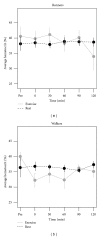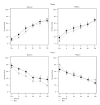Influence of running and walking on hormonal regulators of appetite in women
- PMID: 22619704
- PMCID: PMC3350972
- DOI: 10.1155/2012/730409
Influence of running and walking on hormonal regulators of appetite in women
Abstract
Nine female runners and ten walkers completed a 60 min moderate-intensity (70% VO(2)max) run or walk, or 60 min rest in counterbalanced order. Plasma concentrations of the orexogenic peptide ghrelin, anorexogenic peptides peptide YY (PYY), glucagon-like peptide-1 (GLP-1), and appetite ratings were measured at 30 min interval for 120 min, followed by a free-choice meal. Both orexogenic and anorexogenic peptides were elevated after running, but no changes were observed after walking. Relative energy intake (adjusted for cost of exercise/rest) was negative in the meal following running (-194 ± 206 kcal) versus walking (41 ± 196 kcal) (P = 0.015), although both were suppressed (P < 0.05) compared to rest (299 ± 308 and 284 ± 121 kcal, resp.). The average rate of change in PYY and GLP-1 over time predicted appetite in runners, but only the change in GLP-1 predicted hunger (P = 0.05) in walkers. Results provide evidence that exercise-induced alterations in appetite are likely driven by complex changes in appetite-regulating hormones rather than change in a single gut peptide.
Figures





Similar articles
-
Appetite and gut hormone responses to moderate-intensity continuous exercise versus high-intensity interval exercise, in normoxic and hypoxic conditions.Appetite. 2015 Jun;89:237-45. doi: 10.1016/j.appet.2015.02.019. Epub 2015 Feb 17. Appetite. 2015. PMID: 25700630 Clinical Trial.
-
Potential involvement of lactate and interleukin-6 in the appetite-regulatory hormonal response to an acute exercise bout.J Appl Physiol (1985). 2017 Sep 1;123(3):614-623. doi: 10.1152/japplphysiol.00218.2017. Epub 2017 Jul 6. J Appl Physiol (1985). 2017. PMID: 28684587 Free PMC article.
-
The Effect of a 20 km Run on Appetite Regulation in Long Distance Runners.Nutrients. 2016 Oct 26;8(11):672. doi: 10.3390/nu8110672. Nutrients. 2016. PMID: 27792164 Free PMC article.
-
Effects of exercise intensity on plasma concentrations of appetite-regulating hormones: Potential mechanisms.Appetite. 2016 Mar 1;98:80-8. doi: 10.1016/j.appet.2015.12.016. Epub 2015 Dec 22. Appetite. 2016. PMID: 26721721 Review.
-
Appetite-related peptides in childhood and adolescence: role of ghrelin, PYY, and GLP-1.Appl Physiol Nutr Metab. 2015 Nov;40(11):1089-99. doi: 10.1139/apnm-2015-0050. Epub 2015 Aug 6. Appl Physiol Nutr Metab. 2015. PMID: 26466085 Review.
Cited by
-
Acute exercise and gastric emptying: a meta-analysis and implications for appetite control.Sports Med. 2015 May;45(5):659-78. doi: 10.1007/s40279-014-0285-4. Sports Med. 2015. PMID: 25398225
-
Do Lactation-Induced Changes in Ghrelin, Glucagon-Like Peptide-1, and Peptide YY Influence Appetite and Body Weight Regulation during the First Postpartum Year?J Obes. 2016;2016:7532926. doi: 10.1155/2016/7532926. Epub 2016 May 23. J Obes. 2016. PMID: 27313876 Free PMC article.
-
Reciprocal Compensation to Changes in Dietary Intake and Energy Expenditure within the Concept of Energy Balance.Adv Nutr. 2015 Sep 15;6(5):592-9. doi: 10.3945/an.115.008615. Print 2015 Sep. Adv Nutr. 2015. PMID: 26374181 Free PMC article. Review.
-
Sex differences in the response of total PYY and GLP-1 to moderate-intensity continuous and sprint interval cycling exercise.Eur J Appl Physiol. 2017 Mar;117(3):431-440. doi: 10.1007/s00421-017-3547-7. Epub 2017 Feb 2. Eur J Appl Physiol. 2017. PMID: 28154977
-
Is the Secret in the Gut? SuperJump Activity Improves Bone Remodeling and Glucose Homeostasis by GLP-1 and GIP Peptides in Eumenorrheic Women.Biology (Basel). 2022 Feb 11;11(2):296. doi: 10.3390/biology11020296. Biology (Basel). 2022. PMID: 35205162 Free PMC article.
References
-
- Unites States Department of Health and Human Services. Physical Activity Fundamental to Preventing Disease. Unites States Department of Health and Human Services; May 2008.
-
- Pate RR, Pratt M, Blair SN, et al. Physical activity and public health: a recommendation from the Centers for Disease Control and Prevention and the American College of Sports Medicine. Journal of the American Medical Association. 1995;273(5):402–407. - PubMed
-
- Jakicic JM, Otto AD. Treatment and prevention of obesity: what is the role of exercise? Nutrition Reviews. 2006;64(1):S57–S61. - PubMed
-
- U.S. Department of Health and Human Services. Physical Activity Guidelines for Americans. Washington, DC, USA: U.S. Department of Health and Human Services; 2008. http://www.health.gov/PAGuidelines/guidelines/default.aspx.
-
- Jakicic JM, Clark K, Coleman E, et al. Appropriate intervention strategies for weight loss and prevention of weight regain for adults. Medicine and Science in Sports and Exercise. 2001;33(12):2145–2156. - PubMed
Grants and funding
LinkOut - more resources
Full Text Sources

